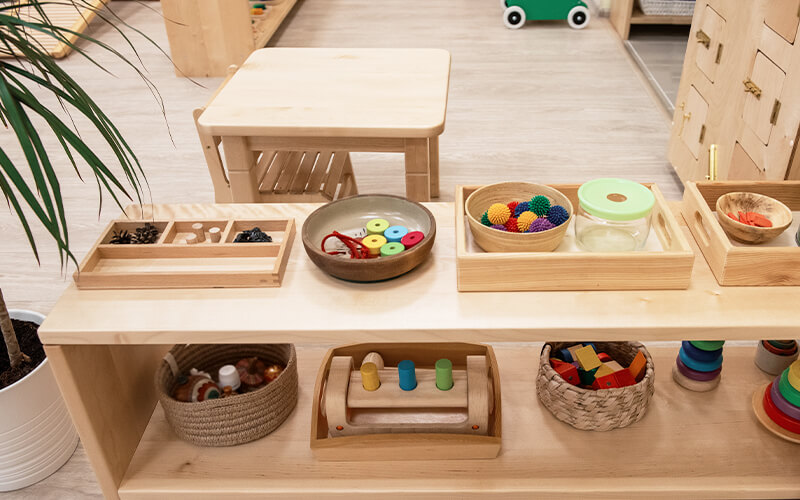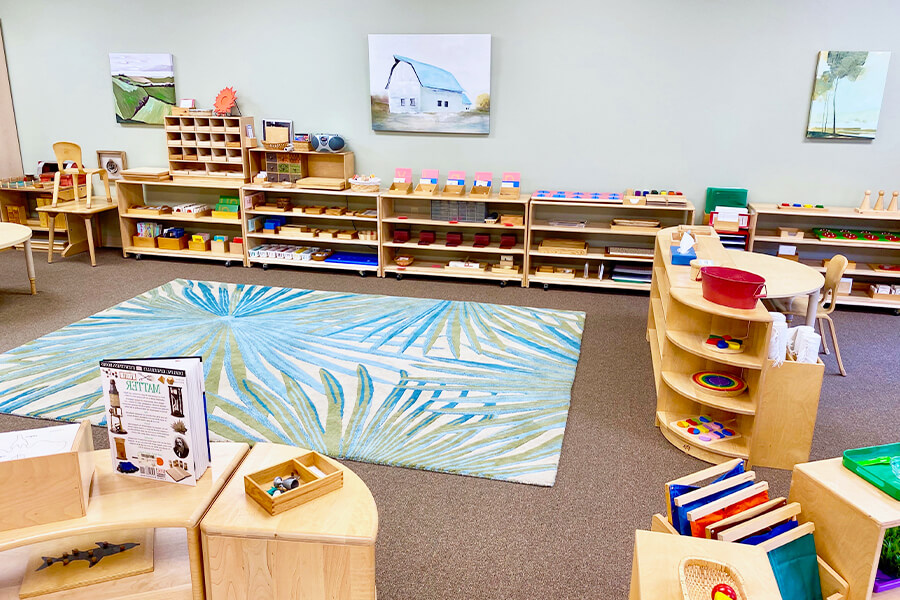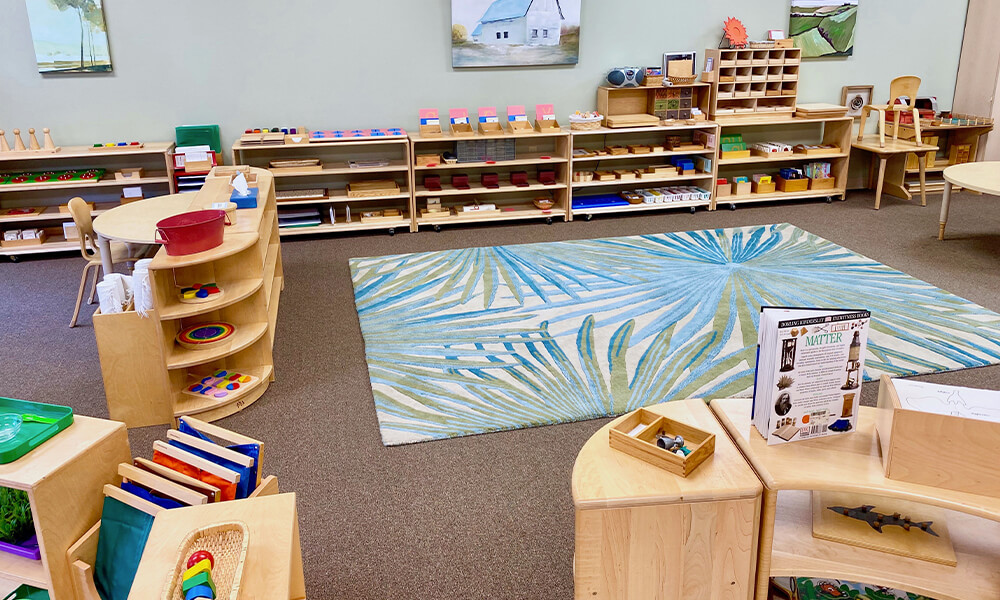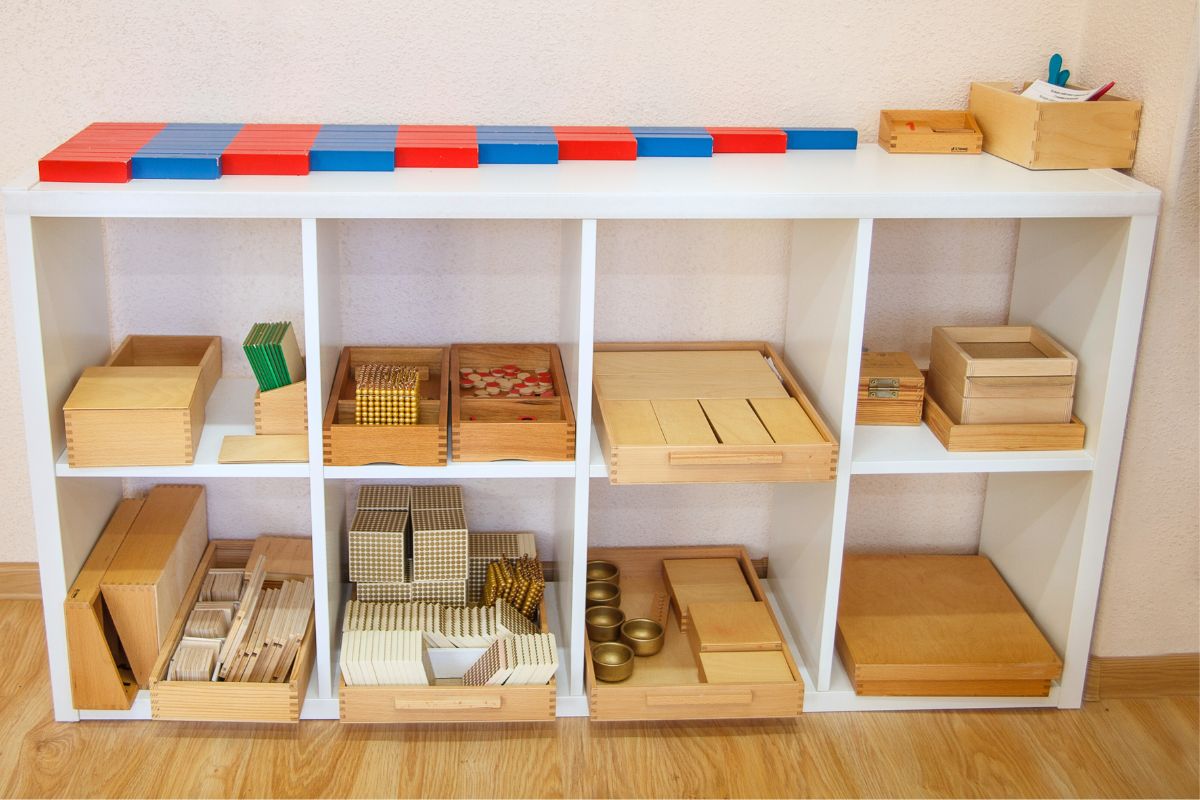The Montessori Method, developed by Dr. Maria Montessori in the early 20th century, has gained widespread recognition for its unique approach to education. Central to this method is the concept of the Montessori prepared environment, a carefully crafted space that fosters a child’s natural curiosity, independence, and self-directed learning.
Key Takeaways
- The Montessori environment is an ecosystem for stimulating a child’s senses and imagination, fueling their intellectual growth.
- The setting is carefully organized, with materials neatly arranged on accessible shelves, promoting calmness and focus.
- Everything is tailored to a child’s perspective, from safety-focused, easy-to-reach materials to a minimalist, natural aesthetic that encourages tranquility and concentration.
- A variety of sensory materials like sand and water invite tactile play, enhancing fine motor skills and cognitive development.
- Age-appropriate, self-correcting materials align with each child’s developmental stage, boosting confidence through personal achievement.
Enriching a Child’s Learning Journey through Organization and Inspiration
The Montessori prepared environment is not merely a physical space; it’s a carefully curated ecosystem designed to stimulate a child’s senses, ignite their imagination, and nurture their intellectual development. At its core lies a profound understanding of child development and the innate desire for exploration that lies within every child.
Key Components of a Montessori Prepared Environment
-
Order and Organization
The prepared environment exudes a sense of order and harmony, fostering a calm and focused learning space. Materials are arranged neatly on low shelves, categorized by their purpose and progression in complexity. This systematic organization allows children to easily locate the materials they need, encouraging independence and self-reliance.
-
Accessibility and Safety
Materials are placed at a child’s eye level and within easy reach, empowering them to explore and learn independently. Additionally, all materials are carefully selected for their durability, safety, and suitability for child-sized hands.
-
Beauty and Austerity
The prepared environment is characterized by a clean, open-plan layout and a minimalist aesthetic. Natural elements like wood, plants, and textiles are incorporated to create a soothing and inviting atmosphere. This balance of beauty and austerity promotes a sense of peace and tranquility, allowing children to focus on their learning.
-
Sensory Delight
The prepared environment is designed to engage all the senses, providing opportunities for tactile exploration, visual stimulation, and auditory engagement. Sensory materials like sand, water, and manipulatives encourage children to develop their fine motor skills and enhance their cognitive development.
-
Age-Appropriate Materials
Materials are carefully selected to align with the developmental stage and interests of each child. They are designed to be self-correcting, allowing children to learn from their mistakes and progress at their own pace. This personalized approach fosters a sense of accomplishment and boosts self-confidence.
-
Variety and Choice
The prepared environment offers a diverse range of materials and activities, catering to the diverse interests and learning styles of each child. This variety stimulates curiosity, encourages exploration, and allows children to delve into areas that pique their interest.
-
Mixed-Age Grouping
Montessori classrooms often incorporate mixed-age groupings, fostering a sense of community and allowing older children to mentor and support younger ones. This interaction promotes social-emotional development and encourages a sense of responsibility and empathy.
Creating a Prepared Environment at Home and in the Classroom
The Montessori prepared environment is a carefully crafted space that nurtures a child’s innate curiosity, independence, and self-directed learning. While Montessori classrooms are renowned for their exemplary prepared environments, recreating this nurturing atmosphere at home is not only possible but also highly beneficial for children’s development.
Home-based Prepared Environment
Transforming your home into a Montessori-inspired learning space can be achieved by incorporating key elements of the Montessori prepared environment.
Prepared Environment for Babies
Babies are naturally curious and eager to explore the world around them. A prepared environment can provide them with the stimulation and support they need to develop their senses, motor skills, and cognitive abilities. Here are some tips for creating a prepared environment for babies at home:
- Provide a safe and comfortable space for play and exploration. This could be a dedicated play area with soft mats and low shelves, or simply a corner of the living room cleared of clutter.
- Offer a variety of textures and objects to explore. This could include rattles, teething toys, soft blankets, and plush toys.
- Hang mobiles or create a sensory wall with items like scarves, mirrors, and colorful fabrics. This will stimulate your baby’s visual and auditory senses.
- Encourage tummy time to help your baby develop their core strength and motor skills. Place a soft mat on the floor and place your baby on their tummy for short periods of time each day.
- Sing songs, read books, and talk to your baby frequently. This will help them develop their language skills.
Prepared Environment for Toddlers
Toddlers are becoming more independent and curious, and their prepared environment should reflect this. Here are some tips for creating a prepared environment for toddlers at home:
- Designate a learning area with low shelves and appropriate materials. This could include Montessori-inspired materials like puzzles, sorting trays, and sandpaper letters.
- Create a sensory area with water, sand, and other sensory materials. This will help your toddler develop their fine motor skills and tactile awareness.
- Provide opportunities for open-ended play with blocks, cars, dolls, and other toys. This will allow your toddler to explore their imagination and creativity.
- Encourage your toddler to help with age-appropriate chores. This will help them develop a sense of responsibility and self-reliance.
- Set up a designated snack and meal area to encourage independent eating.
Prepared Environment for School-Aged Kids
School-aged kids are learning more complex concepts and developing their social skills. Their prepared environment should support their academic and social development. Here are some tips for creating a prepared environment for school-aged children at home:
- Set up a dedicated workspace for homework and independent projects. This could be a desk in their room or a quiet corner of the living room.
- Provide access to age-appropriate books, magazines, and other reading materials. This will encourage your child to develop a love of reading.
- Create a space for them to practice their musical instruments or engage in other creative activities. This will allow them to express themselves and explore their talents.
- Encourage your child to participate in family activities and chores. This will help them develop a sense of belonging and responsibility.
- Foster social interactions with other children by enrolling them in extracurricular activities or organizing playdates.
Classroom-based Prepared Environment
Montessori classrooms are meticulously designed to replicate the natural world, providing a sense of balance and harmony. They are characterized by open-plan layouts, natural light, and a minimalist aesthetic.
- Designate specific areas for different activities, such as language, math, and sensory exploration. This will help children focus and transition easily between activities.
- Use low shelves to display materials and encourage children to access them independently.
- Create a variety of hands-on activities that cater to different learning styles. This will engage all children and allow them to learn at their own pace.
- Observe children closely and provide individualized support when needed. This will help them reach their full potential.
- Encourage collaboration and peer learning among students. This will foster social-emotional development and problem-solving skills.
Incorporating Montessori Principles into Everyday Life
The Montessori method has been consistently shown to produce positive outcomes for children across various domains of development. Studies have demonstrated that Montessori students tend to exhibit higher levels of academic achievement, creativity, self-confidence, social-emotional intelligence, and problem-solving skills. The Montessori philosophy extends beyond the classroom, offering valuable insights for nurturing a child’s development in everyday life. Here are some practical tips to incorporate Montessori principles into your child’s daily routine.
- Encourage Independence: Allow your child to make choices, participate in daily tasks, and set up their own personal space. This fosters a sense of autonomy and responsibility.
- Provide Opportunities for Exploration: Offer age-appropriate materials and activities that encourage exploration and hands-on learning. Let your child explore their surroundings and discover the world around them.
- Create a Stimulating Environment: Make your home an inviting and stimulating place to learn and grow. Incorporate natural elements, sensory materials, and opportunities for creative expression.
- Model Respectful Behavior: Children learn by observing their surroundings. Lead by example by demonstrating respect for others, the environment, and property.
- Seek Out Montessori Resources: Educate yourself about Montessori principles and practices. Read Montessori books, attend workshops, or connect with other Montessori families. This will empower you to create a Montessori-inspired learning environment at home.
Incorporating Montessori Materials and Activities for Maximum Benefits
Montessori materials and activities offer a wealth of benefits for children’s development. These carefully crafted tools provide opportunities for hands-on learning, self-discovery, and problem-solving. To fully reap the benefits of Montessori education, it’s essential to incorporate these materials and activities into a prepared environment that encourages exploration and independence.
Here are some examples of Montessori materials and activities that you can incorporate into your home or classroom:
For Babies
- Touchboards: These boards feature different textures to stimulate the senses and develop fine motor skills.
- Nesting cups: These stacking cups introduce concepts of size, order, and classification.
- Play silks: These soft fabrics encourage movement, sensory exploration, and imaginative play.
- Bathtub Toys: Bathtub toys introduce sensory exploration and promote fine motor skills. Children can explore the different textures and shapes of the toys, and they can also practice stacking and sorting them.
- Mirrors: Mirrors promote self-awareness and encourage imaginative play. Babies can explore their own reflections and use the mirror to create imaginary scenarios.
- Sound Boxes: Sound boxes introduce the concept of cause and effect and encourage auditory exploration. Children can shake the boxes to make sounds and experiment with different rhythms and patterns.
For Toddlers
- Sandpaper Letters: These letters provide tactile experience and help children learn the alphabet.
- Sorting Trays: These trays contain objects of different sizes, shapes, and colors, promoting categorization skills.
- Pegboards: These boards allow children to practice fine motor skills by inserting pegs into holes.
- Shape Sorters: Shape sorters help children develop categorization skills and early math concepts. Children can insert objects of different shapes into corresponding slots, learning about shape recognition and matching.
- Sandpaper Puzzles: Sandpaper puzzles provide tactile experience and help children develop problem-solving skills. Children can use their fingers to trace the puzzle pieces and fit them together, practicing fine motor skills and visual-spatial coordination.
- Water Wheels: Water wheels introduce concepts of cause and effect and encourage scientific exploration. Children can watch the water wheels turn as they fill and empty cups or containers, learning about the relationship between water and movement.
For School-Aged Children
- Number Rods: These rods represent numbers from one to ten, helping children develop early math concepts.
- Pink Tower: This tower consists of different-sized blocks that introduce concepts of size, proportion, and sequencing.
- Botanical Card Boxes: These boxes contain cards with images of various plants, helping children learn about the natural world.
- Number Houses: Number houses represent numbers from one to ten using colorful blocks. Children can build and explore different number houses, learning about the relationship between numbers and corresponding quantities.
- Golden Beads: Colorful beads promote fine motor skills and counting practice. Children can string the beads onto a necklace or bracelet, while also learning about color recognition and counting.
- Geoboards: Geoboards introduce concepts of geometry and spatial reasoning. Children can use rubber bands to create different shapes and patterns on the geoboard, developing their spatial awareness and problem-solving skills.
Additional Tips for Incorporating Montessori Prepared Environment
In addition to incorporating these specific materials, here are some general guidelines for maximizing the benefits of Montessori education.
- Provide ample time for exploration: Allow children to freely interact with the materials and activities at their own pace.
- Respect their independence: Avoid directing or instructing children; instead, observe and offer guidance when needed.
- Emphasize hands-on learning: Encourage children to actively engage with the materials and experiment with them.
- Promote self-direction: Allow children to choose the materials and activities that interest them.
- Create a calm and supportive environment: Ensure that the space is free from distractions and encourages focus and concentration.
Embracing the Transformative Power of Montessori
The Montessori prepared environment provides a nurturing and supportive space that empowers children to discover their passions, explore their curiosity, and develop their full potential. By embodying the principles of the Montessori method in our homes and everyday lives, we can nurture lifelong learners who are confident, independent, and equipped to thrive in an ever-changing world.





